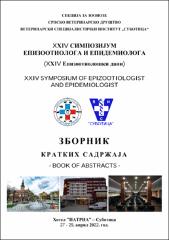Uzročnici virusne etiologije utvrđeni u pobačenim fetusima krmača, krava i kobila u Južnobačkom i Sremskom okrugu od 2019 do 2021. godine

View/
Date
2022-04-27Author
Samojlović, Milena
Petrović, Tamaš
Lupulović, Diana
Lazić, Gospava
Gajdov, Vladimir
Đurđević, Biljana
Lazić, Sava
Metadata
Show full item recordAbstract
Abortions are one of the most important reproductive problems in animal husbandry
causing significant economic losses. Various factors can lead to abortions of domestic
animals of which the infectious ones, especially of viral etiology play an important role.
Therefore in Serbia according to the Program of Animal Health Protection Measures every
occurrence of abortion in sows, cows, sheep, goats and mares must be reported to a
veterinary organization. Besides bacterial agents, viral agents are detected in the aborted
fetuses of sows, cows and mares. The aim of this study was to summarize the results of
all abortions of sows, cows and mares that were admitted for diagnostics as a part of the
Program of Animal Health Protection Measures at Department of Virology at Scientific
Veterinary Institute Novi Sad in a three-year period from 2019 to 2021.
In a three-year period, a total of 305 aborted fetuses of sows, cows and mares were tested
for the presence of different abortogenic viruses in these animal species. In sows tested
viruses included Aujeszky’s disease virus (MAV), porcine circovirus-2 (PCV2), porcine
reproductive and respiratory syndrome virus (PRRSV), porcine parvovirus (PPV), African
swine fever virus (ASFV) and classical swine fever virus (CSFV). In cows bovine viral
diarrhea virus (BVDV) and bovine infectious bovine rhinotracheitis (IBRV) were tested
and in mares equine herpevirus-1 (EHV1) and equine arteritis virus (EAV). PCR/RT-PCT
and real time PCR/RT-PCR methods were used for the detection of viral DNA or RNA in
aborted fetuses depending on the virus. The majority of the tested aborted fetuses were
swine (83.93%), following bovine fetuses (15.74%) and at the end equine fetuses (0.33%).
The positive results were obtained in 2.73% of tested swine fetuses for the presence of
PRRSV, PPV and PCV2, in 4.17% of tested bovine fetuses for the presence of BVDV and
in 100% of tested equine fetuses for the presence of EHV1. The same number of positive
cases of abortions was detected in 2020 and 2021 (4), while in 2019 only one positive case
was detected.
It is evident that abortogenic viruses circulate in pig, cattle and horse population in
Južnobački and Sremski districts with various prevalence among different animal species
and different viruses. The largest number of positive cases was detected in swine abortions
due to the largest number of swine aborted fetuses admitted. Better communication
between farmers and veterinary organizations is needed to be sure that every occurrence
of the abortion is reported in order to get more comprehensive picture of the filed situation
regarding viral causes of abortions in sows, cows and mares.
